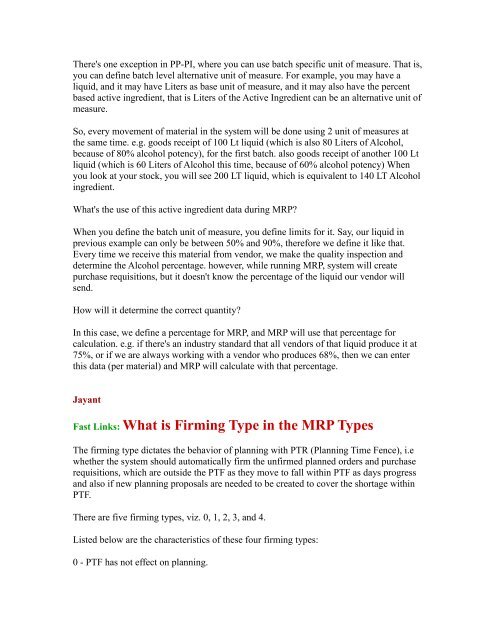SAP Production Planning Table
SAP Production Planning Table
SAP Production Planning Table
Create successful ePaper yourself
Turn your PDF publications into a flip-book with our unique Google optimized e-Paper software.
There's one exception in PP-PI, where you can use batch specific unit of measure. That is,<br />
you can define batch level alternative unit of measure. For example, you may have a<br />
liquid, and it may have Liters as base unit of measure, and it may also have the percent<br />
based active ingredient, that is Liters of the Active Ingredient can be an alternative unit of<br />
measure.<br />
So, every movement of material in the system will be done using 2 unit of measures at<br />
the same time. e.g. goods receipt of 100 Lt liquid (which is also 80 Liters of Alcohol,<br />
because of 80% alcohol potency), for the first batch. also goods receipt of another 100 Lt<br />
liquid (which is 60 Liters of Alcohol this time, because of 60% alcohol potency) When<br />
you look at your stock, you will see 200 LT liquid, which is equivalent to 140 LT Alcohol<br />
ingredient.<br />
What's the use of this active ingredient data during MRP?<br />
When you define the batch unit of measure, you define limits for it. Say, our liquid in<br />
previous example can only be between 50% and 90%, therefore we define it like that.<br />
Every time we receive this material from vendor, we make the quality inspection and<br />
determine the Alcohol percentage. however, while running MRP, system will create<br />
purchase requisitions, but it doesn't know the percentage of the liquid our vendor will<br />
send.<br />
How will it determine the correct quantity?<br />
In this case, we define a percentage for MRP, and MRP will use that percentage for<br />
calculation. e.g. if there's an industry standard that all vendors of that liquid produce it at<br />
75%, or if we are always working with a vendor who produces 68%, then we can enter<br />
this data (per material) and MRP will calculate with that percentage.<br />
Jayant<br />
Fast Links: What is Firming Type in the MRP Types<br />
The firming type dictates the behavior of planning with PTR (<strong>Planning</strong> Time Fence), i.e<br />
whether the system should automatically firm the unfirmed planned orders and purchase<br />
requisitions, which are outside the PTF as they move to fall within PTF as days progress<br />
and also if new planning proposals are needed to be created to cover the shortage within<br />
PTF.<br />
There are five firming types, viz. 0, 1, 2, 3, and 4.<br />
Listed below are the characteristics of these four firming types:<br />
0 - PTF has not effect on planning.



